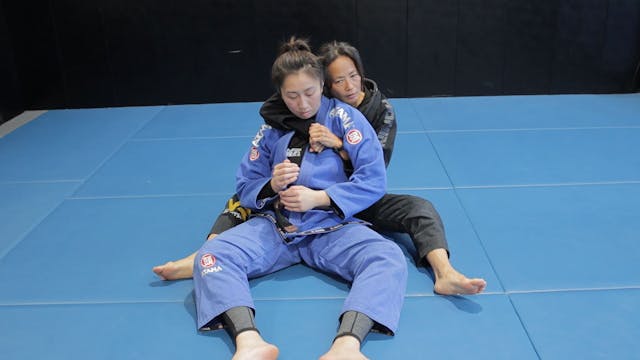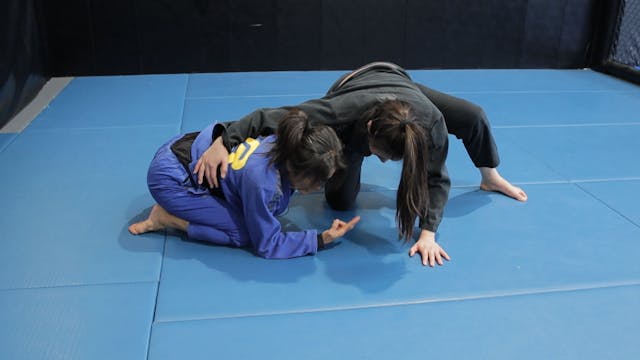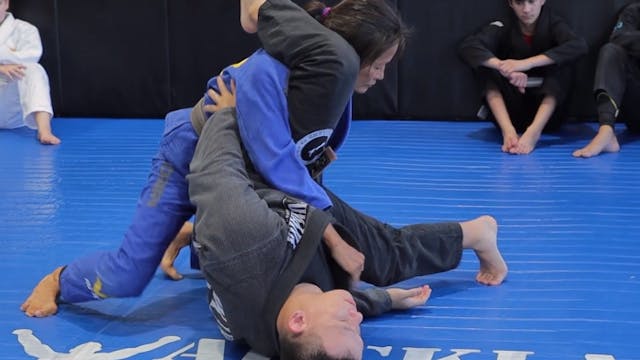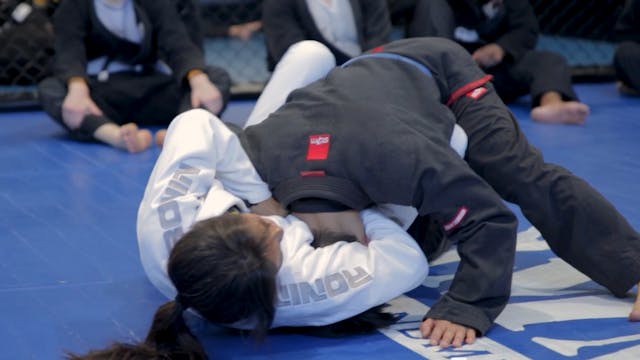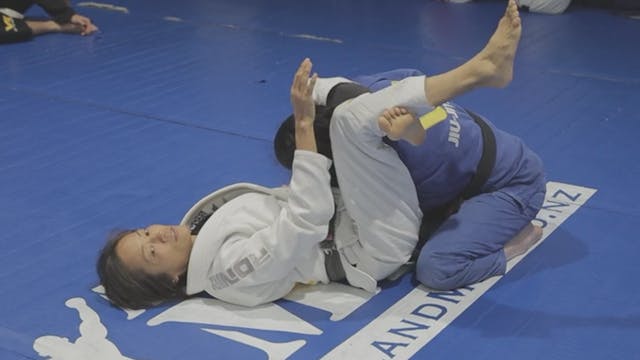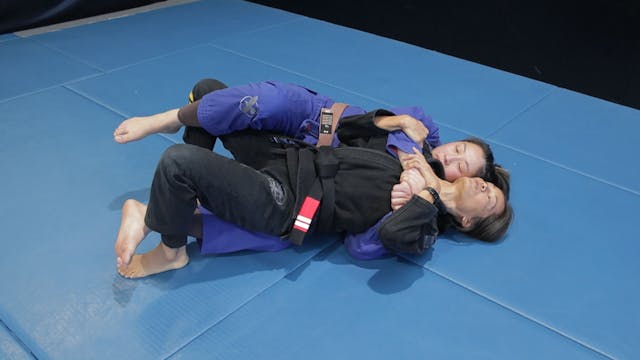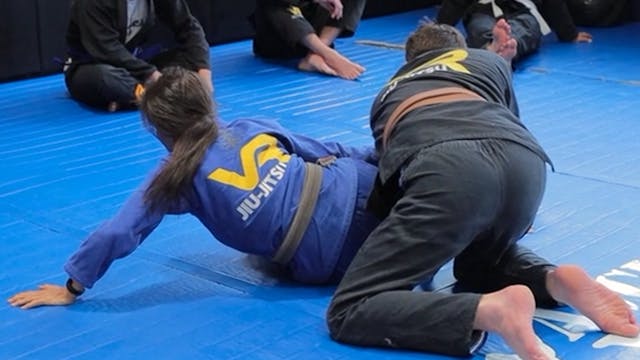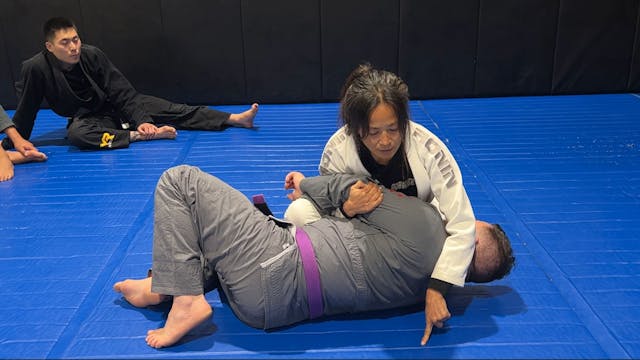VR Jiu-Jitsu Fundamentals
This is a library of the fundamental techniques at VR Jiu-Jitsu. Knowledge of these techniques is required before being promoted to the Blue Belt rank at VR Jiu-Jitsu.
-
Warmups 1 - Rolls, Bridges, Triangles
This video describes how to do the solo warmups for forward roll, backward roll, bridge over shoulder, and triangle shoot.
-
Warmups 2 - Break Fall and Technical Stand
This video shows you how to perform the break fall and the technical stand. Then it shows how you can combine them into a practical sequence that demonstrates how you should safely fall backwards and then get back onto your feet.
-
Warmups 3 - Shrimp and Shrimp to Turtle
This video shows you how to do the shrimp movement (hip escape), and how to follow it up with a movement to turtle and then back to guard.
-
Warmups 4 - S and Hip Switches
This video shows 4 warmup drills: S switches with the knees, S switches with the legs, Hip switches belly up, and Hip switches belly down.
-
Warmups 5 - Butt Scoots, Combat Base, Sit Through, Gecko
This video shows you how to do 4 warmup drills: (1) Forward Butt Scoot (2) Get up to Combat Base (3) Sit Through (4) Gecko Walk
-
Pulling Closed Guard
When you start a match in the standing position, and you want the closed guard position, secure grips on the collar and sleeve. Then put a foot on the hip and sit down while pulling down his upper body. If he remains standing after you sit, raise your hips off the ground using the foot on his hip...
-
Maintaining Side Control
This video shows the proper way to hold down side control using tightness instead of heavy smashing. Use the cross face to prevent him from turning into you, stay on the balls of your feet, and keep center of gravity very low.
-
Maintaining Mount and Technical Mount
The mount position is sitting on the torso below the shoulder line. Your legs must be beneath one or two arms. You can also use the technical mount as the opponent moves onto his side by redistributing your weight among your knee, foot, and hip.
-
Maintaining Good Back Control
To maintain good back control, you must ensure a good seat belt and a good chest-to-back connection with your shoulder glued to the back of the neck. When the opponent is trying to escape, keep a good chest-to-back connection regardless of the configuration of the hook.
-
Maintaining Seated Open Guard
This video shows you the details of how the open guard should be maintained. Sit up leaning forward with your knees wide apart.
-
Position of Turtle for Guard Retention
The turtle position is used to retain the guard. It's normally entered from a seated guard as a result of defending the guard pass. But to effectively sit back into a seated guard from turtle, you must keep the opponent's hips above your shoulder line.
-
Top Position on Opponent's Turtle
When in the top position of the opponent's turtle, you must attempt to get below the shoulder line to get a dominant position. Otherwise your opponent can sit back into a guard.
-
Maintaining Knee Shield Half Guard
The knee shield half guard is when you have half guard, but you are on your side with your top knee keeping distance. Keep you're knees apart and ensure that your bottom knee is also in front of the opponent's hip.
-
Top Position of Combat Base
When you are in top position on your knees, combat base is a ready position that prevents the closed guard and also allows easy movement into the knee slice or standing position. Stay on the ball of the supporting foot of the kneeling leg.
-
Top Position of North South
The North South top position is when you pass the guard and maintain chest-to-chest dominant control with your legs 180 degrees away from his legs. You normally get to this position from side control when he attempts to recover his guard.
-
Top Position of Knee Ride
The top position of knee ride is a dominant position from passing the guard and placing one knee on the opponent's belly. The other knee needs to be off the mat.
-
Understanding Spider Guard
Spider guard is a position where you have double sleeve grip on the opponent and your feet are maintaining the distance on the opponent's hips, thighs or biceps.
-
Guard Position of De La Riva
The De La Riva guard is when you control one leg with your outside leg hook and your ankle grip. You also control the opponent's angle with the other leg on the hip or upper thigh. When the opponent breaks down this guard, he would normally stuff the foot on his hip or thigh between his legs. To ...
-
Guard Position of Reverse De La Riva
Reverse De La Riva is a guard position with an inside leg hook and inside ankle grip. You are on your side to stop head control, and you other leg is maintaining the distance with either on the near hip or controlling the nearside arm
-
Grip Break - Sleeve and Collar using 2 hands
When opponent grabs the hem of your sleeve (cross or same side), an easy grip break is to use 2 hands. You can also use 2 hands to break a collar grip (cross or same side).
-
Grip Break of Pants using counter sleeve grip and kick
When the opponent grips your pants, you can counter grip his sleeve and kick your leg straight to break the pants grip. This is normally done from your spider guard when he counter grips your pants.
-
Grip Break on Pants using Scoop
When you are in seated open guard and your attempts to gain a pant grip before you are ready to engage a guard, a scoop grip is a fast means of breaking the grip without needing to counter sleeve grip.
-
Mount Escape Fundamentals
This video shows guard recovery from the opponent's mount position with the technique depending on how the opponent is mounted.
-
Fundamentals of Side Control Escape - Part 1
When the opponent has just passed your guard while you are on your back, prevent the head control and shrimp onto your side to recover your guard.
-
Fundamentals of Side Control Escape - Part 2
When opponent gets connection to your head and chest-to-chest compression, you need to start your arm frames and do a high bridge to the side to create the space you need when you drop your hips into a shrimp.
-
Fundamentals of Side Control Escape - Part 3
When you do a full bridge, but cannot create enough space for a big shrimp, aim to get just a bit of your knee in front of the opponent to begin building your frame.
-
Fundamentals of Side Control Escape - Part 4
Instead of increasing your frame to replace your guard, you can choose to get an underhook after controlling the opponent's leg and then progress to a sweep and pass.
-
Fundamentals of Side Control Escape - Part 5
When the opponent has just pass your guard, you can choose to turn on your side and get the underhook to immediately start your sweep and pass.
-
Stack Pass Fundamentals - Part 1
The stack pass is common to do once your opponent’s guard opens and you’re already on your knees. This video shows entry from the closed guard break while on your knees
-
Stack Pass Fundamentals - Part 2
When opponent resists your stack pass attempt by using his feet to push off your hips and plank his body, you angle and get one leg over the shoulder and pin the knee on his other leg to complete the pass. This is sometimes known as the Over Under Pass.
-
Stack Pass Fundamentals - Part 3
When you have the modified stack pass where one leg is over your shoulder and you are pinning the other leg with your hand, and the opponent makes it difficult for you to pass the original side, you can switch the passing side by stapling the non stacked leg and then blocking the kneeshield with ...
-
Stack Pass Fundamentals - Part 4
When you modify the stack pass to function like the over under pass, and the opponent does not allow you to pin his far leg to the floor, you can switch back to the stack pass by keeping his hip very high in the air and continuing to press his knee to his face.
-
Armbar Escape using Figure 4 arm frame
The Figure 4 arm frame is using the hand of the arm in danger to grab your opposite bicep and locking in the frame with your other hand behind your opponent's leg. This counter is best executed on your knees where you can stack your opponent and pass his guard after escaping.
-
Scissor Sweep Fundamentals
Details on how to execute the Scissors Sweep from closed guard with crucial details on how to deal with the resistance opponents give.
-
Reverse De La Riva Fundamentals
Basic body positioning for Reverse De La Riva. DLR to Reverse DLR transitions. Reverse DLR to block knee slice pass. Reverse DLR used to sweep, bac ktake, or leg drag.
-
Arm Triangle (Head & Arm) Choke Fundamentals
How to setup the Arm Triangle from opponent's frame while under your side control
-
Wristlocks
Bend the wrist back or forward at right angle to the forearm. Then trap the elbow and press the wrist into a further bend.
-
Triangle Choke from Closed Guard
How to execute the details of finishing the triangle choke from the closed guard. Pay special attention to how your choking leg lands into position before locking up the triangle.
-
Osoto Gari Takedown
This takedown uses an outside leg reap from standing. Grab a collar grip. Pull them forward to get the reaping leg to step forward. Then step your leg behind his leg, bend forward while pushing his torso down and pulling the sleeve back.
-
Double Leg Takedown
Change levels, step forward so that your foot lands under their hips and your shoulder hits the belly. Secure hands behind both legs near the knee. Then step the other forward and tilt your head to the side to push them laterally while holding their legs.
-
Ankle Pick Takedown
Push the same-side collar grip to get the weight off the nearside leg, and then pick up the ankle with your other hand. Use the inside hand to pick up the ankle for easier access to the backside.
-
X-Guard to Technical Stand Up Sweep
When in X-Guard and you do not have any upper body grips, you can push all his weight onto the far leg, and then underhook the near leg. This allows you to do a technical stand up with a single leg.
-
X-Guard Ankle Pick Sweep
When in X guard, you can stretch out the far leg and then pick up the ankle with your lower hook. You can do this in 2 separate moves or one single move. You do not need any upper body grip to execute this sweep.
-
Spider Guard Scissor Sweep
When your opponent is kneeling from within your spider guard, you can put one foot on the bicep and use the other foot to take away his base while you direct his bicep towards the sweep.
-
Balloon Sweep from Spider Guard
When the opponent is standing in your spider guard, you can use the double sleeve grips to pull his hip weight forward onto your feet. Then you can catapult him over your head while pushing his sleeves towards your hips.
-
Pendulum Sweep
From closed guard, control opponent's arm on sweeping side and underhook opposite leg. angle body at right angle. Then use your leg as a pendulum to generate energy to sweep.
-
Omoplata Sweep
You can threaten the Omoplata shoulder lock as a means to achieve a sweep to a dominant position. When the opponent realizes it's an omoplata, he may defend by rolling forward. Get up into the bicep sandwich on his arm to control the top position.
-
Flower Sweep
While in closed guard, secure same side sleeve grip and opposite pant grip. Then open closed guard, pull forward, trap the leg and push over with your leg.
-
Three leg positions of X-Guard
When you enter the X-Guard, you bring your hips underneath your opponent's hips and use your legs to control his legs. One of your knees must be in front of his hip, and one behind to create the X configuration on her legs. The 3 positions are (1) normal X-Guard where the X of your legs is on his...
-
Torreando Pass pushing feet to mat
When approaching the open guard and you can secure a pant grip on each leg, you slam the feet to the mat and hop to the side to prevent spider guard entry. Then put in a divider with either your knee or your shoulder. Swap grips to complete the pass only after his shoulder is on the mat.
-
Smash Pass from Knee Shield Half Guard
When the opponent has knee shield half guard, you get grips on the knees and lift his legs to the other side and smash his legs together while stapling his shin. Then you can pass from the smash or move into the leg weave.
-
Passing the Quarter Guard
When in mount and the opponent has a quarter guard, you must remove his defensive arms by securing double underhooks. Then you can use your free foot to help free the trapped foot.
-
Omoplata Shoulder Lock and Set Up from Closed Guard
Set up the Omoplata from closed guard. Once you pass the leg over the face, push face away and build height. Take care in curling the legs to the other side.
-
Kimura from Knee Shield Half Guard
When you have knee shield half guard, and you secure kimura grips, you finish the Kimura by removing the knee shield and then rolling all the way to the other side to face his head while applying the shoulder lock.
-
Ezikiel Choke from anywhere
The Ezikiel Choke is a choke that can be applied from any position if you can isolate the opponent's head with your arms. Hug the head, grab inside the hem of your own sleeve, apply the blade of your hand into the neck, and then apply the choke by attempting to straighten out your arms.
-
Triangle Escapes by Stretching
When the figure 4 leg configuration is locked in, you can still escape if you twist to the choking side and then stretch out your upper body while keeping the hips still.
-
Cutting Armbar from Mount or Side Control
When opponent straightens either arm in your mount, you can trap the wrist against your neck and shoulder and wrench the elbow so the arm locks in straight, then push the elbow into your body. You can do the same for the far arm in your side control when he turns into you.
-
Cutting Armbar from Guard
When you have closed guard, you can pull the opponent's arm forward so that his wrist is close to your head. Then you can trap his wrist between your neck and shoulder and angle to your side. Locate the elbow and wrench it straight for the finish.
-
Backtake from Side Control
When you have side control, you can push the opponent onto his side, apply a giftwrap, align your shin to his back, sit back, and pull him to the other side for the backtake.
-
Backtake from Mount
When you have mount and the opponent turns to one side in an effort to push one of your legs into a guard, you can trap him on his side and apply a giftwrap hold to and sit back to pull him onto the other side for back control.
-
Backtake from De La Riva Baby Bolo
Backtake from De La Riva guard by making the DLR hook deep onto the far hip. Then apply crab ride hooks from behind, grab belt, and scoot over to back angle.
-
Armbar from Triangle
Attack the arm inside the triangle hold by lifting hips to apply pressure on the elbow. You can also isolate the arm by swinging the leg under the armpit over the head to squeeze your thighs for a tight finish.
-
Armbar from S-mount
Armbar from S-mount with details on how to isolate the arm with a tight leg configuration and how to get a tight finish.
-
Guillotine Fundamentals with Escapes
This video explains the details for the basic guillotine with the arm in and the basic guillotine without the arm in. It includes the basic escapes for these guillotines.
-
Clock Choke Fundamentals
Fundamental concepts in the Clock Choke. Includes a finishing variation, how to enter from back control, and why it's called the clock choke.
-
Clock Choke Counter Sweep to side control
When the opponent is attempting a clock choke, and he puts his arm under your far armpit, you can trap his arm and roll over your far shoulder for a sweep to side control.
-
Cutting Armbar from Closed Guard
When your opponent places his hand near your neck in your closed guard, you can execute a cutting armbar.
-
Kimura from Side Control
When the opponent hugs your head or turns his arm downward to avoid the Americana or armbar, you can execute a Kimura. This video shows details on how you can finish the Kimura with the maximum control of body.
-
Baseball Bat Choke
Explanation of the Baseball Bat Choke with crucial details in ensuring that you can complete the choke once you get the grips.
-
Relationships among Triangle, Armbar, and Omoplata
This video shows some transitions of your guard attacks that shows the relationship among the triangle, armbars, and omoplata.
-
Arm Triangle (Head & Arm choke) started from Mount
You can force the Arm Triangle when in mount by getting underneath the defending arm and forcing it high on the head, and then executing the head an arm choke. (some of the speech is muffled by the gi during the demo)
-
Loop Choke with leg over shoulder
From cross collar and sleeve guard, you can take away his base with your leg, then get up onto your knees to quickly capture the head in your armpit. Then sit down again throwing your leg over his shoulder to stop his defense of spinning out.
-
Half Guard Pass using opponent's lapel
When you get passed the opponent's knee shield into half guard, you can pin his back to the mat and pass using his lapel.
-
Reverse Half Guard Pass
This video defines the reverse half guard and explains when it's applicable. It also shows details of how to successfully pass the reverse half guard.
-
Muscle Sweep from Closed Guard
In closed guard, secure a cross sleeve grip. When he stands up to break your closed guard, you get an underhook on his leg and buckle his knee outward to get him to fall. Then push yourself up to mount.
-
Fundamentals Underhook Sweep from Half Guard
From knee shield half guard, get the underhook to begin a sweep From this set up, you can execute different sweeps depending on your opponent's reaction, .
-
Fundamentals of Reverse Half Guard
When in the chest to chest half guard top, but the opponent gets the underhook, you can enter reverse half guard to pass.
-
Low Knee Cut pass when your foot is stuck
When attempting a Knee Cut and the opponent captures your foot and holds it tightly, you can clear your foot by lowering your head to the mat and getting 2 deep underhooks.
-
Catapult Sweep
The Catapult Sweep is sweeping the opponent by control one arm with your leg and underhook on his opposite leg.
-
Fundamentals of Stack Pass with Over/Under variation
You can do the stack pass from double underhook of the opponent's legs, and then transition into an effective over/under variation when you fail to raise his hips.
-
X Pass Fundamentals - Part 1
Part 1 of 3. When opponent has you in an open guard with a light hook, you can do an X Pass into the Knee Ride.
-
X Pass Fundamentals - Part 2
Part 2 of 3. Variation of X Pass where you place one hand on hip and the other hand on knee. Then move to right angle and place shoulder into his stomach to complete the pass.
-
X Pass Fundamentals - Part 3
Part 3 of 3. When opponent counters your hand-on-hip X-Pass by using stiff arms on your shoulder, you can circle back in to push his hips flat and then finish the pass with a knee ride.
-
Escape Back Control using Shoulder Scrape
When in back control with a seatbelt, you immediately put your head to the mat on the underhook side and scrape your shoulders along the mat. Ensure that you do not allow the full mount once the opponent has decided to abandon the back control.
-
Escape Back Control using Arm Over Head
When in the opponent's back control, you can seize the opponent's choking arm and bring it to the other side of your head. Then turn into him to escape his back control, while trying to avoid the closed guard.
-
Fundamentals of Knee Cut Pass
How to execute the knee slice pass with maximum control. Crucial details to prevent common counters.
-
Closed Guard Break by Standing with Knee Wedge (part 1)
When in closed guard, you secure lapel and sleeve grips. Then stand up and align your knees against the bum and round your back. When guard opens, you immediately staple the leg, secure a cross face and back step out of the guard. Finish with stapling leg for the pass. Part 1 of 2.
-
Closed Guard Break by Standing with Knee Wedge (part 2)
When the opponent pulls your posture, you push into his armpits to avoid attacks. Then you get off your knees and walk your feet towards his bum to apply the knee wedges. Then secure your grips and open the guard as if you had your posture to begin with. Finish with stapling leg for the pass. Par...
-
Closed Guard Break by Lifting Opponent
When in closed guard, you can stand up and lift the opponent with you and then shake while pushing on the legs to break open the guard. Then staple the leg to the floor to complete a pass.
-
Closed Guard Break by Standing in NoGi
When in closed guard in NoGi, secure two-on-one grip of opponent's arm. Then stand up and push down on one leg to open guard, similarly to the Gi standing guard break. Then staple leg and secure crossface and leg hug to complete the pass.
-
Hip Drag Takedown
When standing, if you get hug the hips from a back angle, you can trip the far leg and drag the hip to the mat for a takedown.
-
Seated Guard Sweeps and Single Leg Takedowns
This video explains the when the seated guard is appropriate, and shows the sweeps and takedowns you can do with capturing one leg in your seated guard. You can "run the pipe," do a hip drag, or do a double leg takedown.
-
Americana from Side Control top
When you have side control on your opponent, and he puts arm frame in front of your head, you can attack his arm with an Americana shoulder lock by pushing his wrist to the mat and connecting your arms.
-
Rear Choke in NoGi
The rear choke from back control without use of gi grips is called the "Rear Naked Choke" (RNC). The standard RNC uses both of your arms locked together. This video shows details on how to safely lock the arms together to minimize the opponent's defense.
-
Rear Choke using Gi
When you have back control with the seat belt, these are common chokes using the gi to secure the choke from behind.
-
Fundamentals of Cross Collar Choke From Guard with lapel variations
Details for an effective cross collar choke from closed guard and variations using the opponent's lapel. There here are also details on how to relate the chokes from guard to the top position, and execute the lapel variation from side control.
-
Tripod Sweeps
Tripod sweep with your foot on the same side sweep (push-pull sweep), and a variation with the opposite foot on hip (sickle sweep).
-
Collar Drag Sweep
When you have seated guard, and the opponent is on his knees, you can use the collar drag to get access to the opponent's leg and drive his head towards the mat while you lift his leg to flip him over.
-
Collar Drag to Backtake
When you use the Collar Drag, either from standing or from your seated guard, you can use it to gain access to his back if you immediately secure a grip near his far armpit.
-
Collar Drag Takedown
When both are standing in a match, you can use the collar drag to access the leg for a takedown. If he lands on his hands, lift his leg while pushing his collar to the ground to flip him over. If he remains on his feet, lift the leg up while using the collar grip to compromise his balance.
-
Farside Armbar from chest-to-chest side control
When you have side control, and you isolate the opponent's far arm, you push his wrist to the mat and interconnect your arms to do a cutting armbar.
-
Kimura from Closed Guard
This video shows you how to create the conditions to execute the Kimura from your closed guard. It includes details that will make the kimura tighter.
-
Stiff Arm to Elbow Push escape from side control
When opponent passes your guard and counters your stiff arm escape by switching his base and bringing his elbow over you body, you immediately execute the Elbow Push escape.
-
Leg Weave Pass from Knee Shield Half Guard
When the opponent has a knee shield half guard, you can use your shoulder or chest to pinch the knees together, place your head on the far shoulder and grip the collar to complete the leg weave pass.
-
Folding Pass from Knee Shield Half Guard
When the opponent has knee shield half guard, you can grip his knees and bring to the far side and slide your knee between his thighs. Keep head low against his shoulder and clear his hooks. Then pass to the original side.
-
Farside Spinning Armbar from Side Control
When you have side control, you can start attacking an Americana. If he defends by bringing his arm on the other side to hug your head, you can wrench his arm at his elbow, step over his head, grab his pants, and spin into an armbar. This includes preventing him from defending using his grips.
-
Farside Spinning Armbar from Knee Ride
When you are in Knee Ride, and your opponent pushes on your knee to counter, you get an underhook on the pushing arm, step over his head, grab his pants, and spin into an armbar. Details are included about where to place your arms and where to step.
-
Reverse Sweep from Underhook Half Guard
When the opponent has a wizzers on your underhook from half guard, trap his wizzer arm, pull his inside leg so that his knee turns in (cayote hook), and then scoot underneath for a reverse sweep.
-
Single Leg Sweep from Underhook Half Guard
Get to the underhook from knee shield half guard, switch leg hooks, and then do the single leg sweep by driving forward until the opponent is seated.
-
Backtake from Underhook Half Guard
Take the back from your kneeshield half guard using underhook by throwing his arm off your back and onto the floor. Then move to secure a seatbelt and take his back.
-
Limp Arm escape from Underhook Half Guard
Use the Limp Arm escape when the top opponent overhooks your underhook from your half guard. use your underhook to move his weight forward onto his hands and then turn your elbow up. Then look backwards as you pull your arm out.










